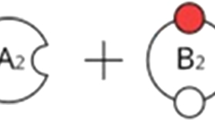Abstract
We summarize three of our recent results on diffusion-influenced reactions in solutions. All deal with the concentration dependence of the reaction rate when the reactants must first diffuse together before reaction can occur. When one species (the sink species) is not dilute, the rate cannot be obtained by solution of a pair diffusion equation; the correlations among the sinks for the diffusing species must be accounted for. First, we consider fluorescence quenching when the quenchers are not dilute. For charged quenchers and fluorophores we discuss how the solution dielectric constant and ionic strength can strongly influence the deviations from the linear Stern-Volmer behavior (the dilute sink result) which arise due to the sink correlations. Second, we consider heterogeneous catalysis where a reactive species is adsorbed onto a surface and must surface diffuse to reactive sites (the sinks). We find that surface diffusion can be an important factor contributing to the rate of reaction; especially when surface diffusion is rapid relative to the adsorption/desorption rate. Third, we discuss diffusion influenced reactions with sinks which are long ellipsoids. Dilute long ellipsoids provide a large rate enhancement relative to a spherical sink; we show that this rate enhancement survives when nondilute ellipsoids are considered.
Similar content being viewed by others
References
M. von Smoluchowski,Phys. Z. 17:557, 585 (1916);Z. Phys. Chem. 92:129 (1917).
R. E. Weston and H. A. Schwartz,Chemical Kinetics (Prentice-Hall, Englewood Cliffs, New Jersey, 1972), Chap. 6.
R. M. Noyes,Prog. React. Kin. 1:128 (1961).
O. Stern and M. Volmer,Phys. Z. 20:183 (1919).
G. Somorjai,Chemistry in Two Dimensions: Surfaces (Cornell University Press, Ithaca, New York, 1981).
P. H. Richter and M. Eigen,J. Biophys. Chem. 2:255 (1974).
O. G. Berg, R. B. Winter and P. H. von Hippel,Trans. Biochem. Sci. 7:52 (1982); O. G. Berg and P. H. von Hippel,Ann. Rev. Biophys. Chem. 14, 0000 (1985).
B. U. Felderhof and J. M. Deutch,J. Chem. Phys. 64:4551 (1976); B. U. Felderhof,J. Chem. Phys. 66:4385 (1977).
J. R. Lebenhaft and R. Kapral,J. Stat. Phys. 20:25 (1979).
M. Muthukumar and R. I. Cukier,J. Stat. Phys. 26:453 (1981).
M. Muthukumar,J. Chem. Phys. 76:2667 (1982).
T. R. Kirkpatrick,J. Chem. Phys. 76:4255 (1982).
M. Tokuyama and R. I. Cukier,J. Chem. Phys. 76:6202 (1982); R. I. Cukier,J. Stat. Phys. 30:383 (1983).
R. I. Cukier and K. F. Freed,J. Chem. Phys. 78:2573 (1983).
J. Keizer,J. Chem. Phys. 79:4877 (1983).
D. A. McQuarrie,Statistical Mechanics (Harper and Row, New York, 1976).
H. Mori,Prog. Theor. Phys. 53:1817 (1975); H. Mori and D. J. McNeil,Prog. Theor. Phys. 57:770 (1977).
R. I. Cukier,J. Phys. Chem. 87:582 (1983).
J. K. Baird and S. P. Escott,J. Chem. Phys. 74:6993 (1981).
J. Keizer,J. Am. Chem. Soc. 105:1494 (1983);J. Phys. Chem. 86:5052 (1982).
D. Peak, T. C. Werner, R. M. Dennin, Jr., and J. K. Baird,J. Chem. Phys. 79:3328 (1983).
R. I. Cukier,J. Chem. Phys. 82:5457 (1985).
R. I. Cukier,J. Am. Chem. Soc. 107:4115 (1985).
N. Sutin,Prog. Inorg. Chem. 30:441 (1983).
P. Debye,Trans. Electrochem. Soc. 82:265 (1942).
W. Rybak, A. Haim, T. L. Netzel, and N. Sutin,J. Phys. Chem. 85:2856 (1981).
R. M. Fuoss,J. Am. Chem. Soc. 80:5059 (1958).
M. Eigen,Z. Phys. Chem. N.F. 1:176 (1954); M. Eigen, W. Kruse, G. Maass, and L. DeMaeyer,Prog. Reac. Kin. 2:285 (1964).
R. I. Cukier (unpublished).
M. R. Flannery,Phys. Rev. Lett. 47:163 (1981);Phys. Rev. Lett. 48:1573(E) (1982);Philos. Trans. R. Soc. London Ser. A 304:447 (1982);Phys. Rev. Lett. 49:1681 (1982).
M. Fixman,J. Chem. Phys. 81:3666 (1984).
A. Adamson,Physical Chemistry of Surfaces, 4th ed. (Wiley, New York, 1982), p. 627.
R. I. Cukier,J. Chem. Phys. 79:2430 (1983).
S. Prager and H. Frisch,J. Chem. Phys. 72:2941 (1980).
H. C. Berg and E. M. Purcell,Biophys. J. 20:193 (1977).
R. I. Cukier (unpublished).
R. I. Cukier,J. Phys. Chem. 89:246 (1985).
P. M. Morse and H. Feshbach,Methods of Mathematical Physics (McGraw-Hill, New York, 1953), pp. 1284ff, 1502ff.
R. Kapral and D. Bedeaux,Physica A 91:590 (1978); M. Muthukumar,J. Chem. Phys. 77:959 (1982).
F. C. Collins and G. E. Kimball,J. Colloid Sci. 4:425 (1949).
Author information
Authors and Affiliations
Rights and permissions
About this article
Cite this article
Cukier, R.I. Diffusion-influenced reactions. J Stat Phys 42, 69–82 (1986). https://doi.org/10.1007/BF01010841
Received:
Issue Date:
DOI: https://doi.org/10.1007/BF01010841




